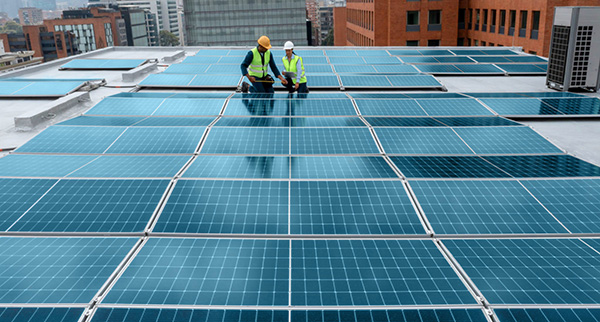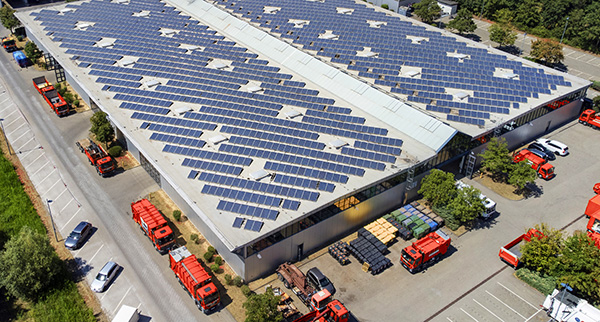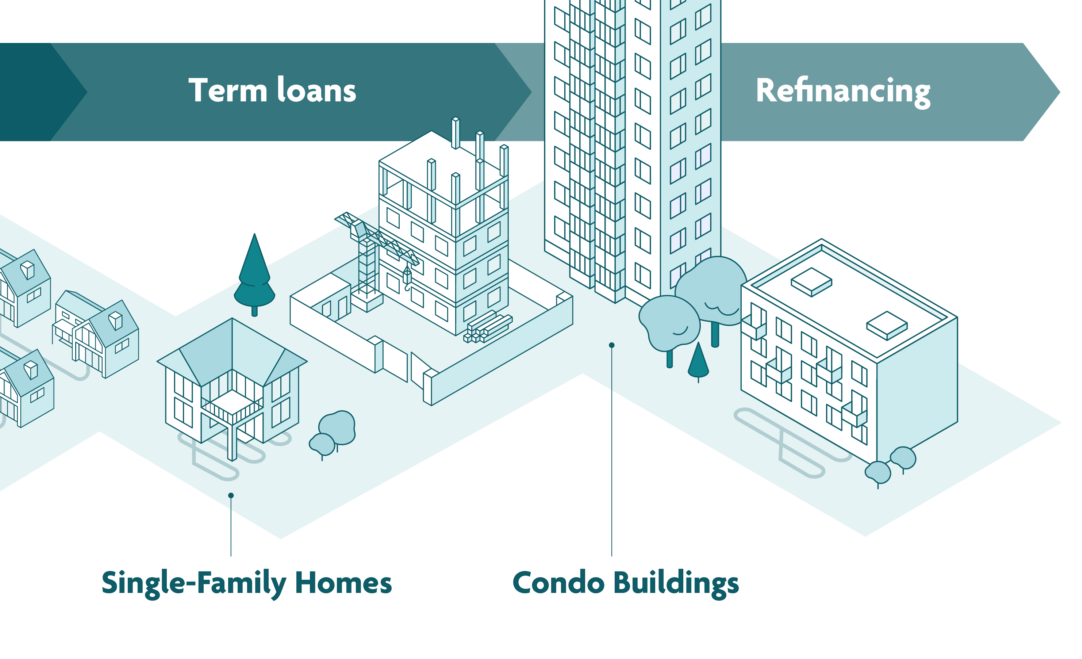It’s one of the biggest untapped opportunities in the Canadian renewable energy market.
A well-established but under-utilized pathway for developers and investors to generate steady cash flow with projects that also contribute to local resilience and business continuity, and for governments at all levels to help them get the job done.
And with interest in commercial/industrial solar on the rise and new financing solutions becoming available, it may be coming soon to an existing building, new construction site, or residential complex near you.
The market segment known as commercial/industrial (C/I) or mid-market solar consists of four- to 50-megawatt installations that are smaller than a utility-scale solar farm but bigger than a home rooftop array. They can be set up to feed electricity directly to the grid. But they’re also the right size to supply distributed, behind-the-meter power where provincial regulations allow them to.
Either way, a well-designed C/I project can provide steady cash flow for investors and greater flexibility for utilities. Behind-the-meter projects can also give building owners and occupants a decisive advantage by stabilizing and reducing their energy costs while reducing operating emissions. Often an even more important driver, they deliver resilience for buildings and communities and better safety for occupants by keeping the lights on and equipment running when a heatwave, wildfire, or severe storm takes the power grid offline.
By replacing electricity generated by fossil fuels, commercial/industrial solar projects help governments keep their promises to reduce the greenhouse gas emissions that drive an accelerating global climate emergency while enabling the private sector to make decisions and investments for resilience, economic benefit and environmental performance. All of these advantages demonstrate that the shift to renewable energy is about opportunity and gain, not loss and pain.
There are no reliable public figures for the number, size, or output of commercial/industrial solar installations in Canada. In the United States, commercial and community solar represented just small slivers of the more than 200 gigawatts (GW) of solar capacity installed nation-wide through June, 2024, according to the U.S. Solar Energy Industry Association.
But with a new federal tax credit now in place in Canada, commercial/industrial solar has never been more practical or affordable.

A Serious Prospect for Owners and Developers
Commercial/industrial solar is just beginning to gain recognition as a serious prospect for building owners and solar developers. It’s an obvious consideration for new greenfield development, especially as Canada and other countries move into an intensive period of new home construction. It’s also an opportunity worth exploring for any existing property with roof space, a parking lot, or any other open expanse where it might make sense to install solar panels for commercial/industrial applications.
And in provinces where net metering programs apply to commercial/industrial solar, developers can send their surplus power back to the grid and receive a credit on their electricity bills.
In late 2020, energy market analysts at Wood Mackenzie estimated the U.S. potential for new commercial solar capacity at 145 GW. At the time, only 3.5% of commercial buildings were equipped with solar arrays, while another 1% had connected to community solar.
In 2023, a study for the Canadian Renewable Energy Association (CanREA) found [pdf] that behind-the-meter solar could grow 20- to 40-fold by mid-century, enough to produce 18.8 GW of electricity per year, given the right financial and policy supports to expand the market. (A gigawatt is a billion watts of electricity, but the actual value of that output varies across the country depending on how efficiently a solar array captures energy and how efficiently it’s used. Alberta and Saskatchewan have the best solar resources of any Canadian province.)
The public release of the CanREA report didn’t differentiate between home rooftops and larger commercial, industrial, or community systems, pointing to a wider set of questions that help define the commercial/industrial potential:
- How many warehouses are there in Canada? How many big-box supermarkets or department stores? Or parking lots? Or data centres?
- How many square feet of roof space do these, and other facilities, represent, and what share of that total would be suitable for solar development?
- With the country entering a new boom in home construction and renovation, where are the opportunities to install community solar systems that serve multiple homes, apartment buildings, housing co-ops, non-profit housing developments, or condominiums/stratas, including the large percentage of homes that are locked out of rooftop solar?
A quick data scan indicates nearly two billion square feet of industrial and logistics sites in Canada (though they aren’t all single-storey), 493 department stores, 71 to 97 million parking spaces, and 336 data centres.
Those numbers don’t easily translate into a sudden avalanche of project activity. Each site is unique, with its own possibilities, needs, and constraints. But they do point to the opportunity to work from the ground up, building successful projects where owners see the benefits, developers are ready to deliver, and responsive financing is available to seal the deal.
Getting From Here to There
For any renewable energy project, developers have to put in the time and effort to get the best energy output from a site, anticipate and minimize impacts on the environment, habitats, and natural heritage, and build a strong base of public support for their plans.
“Renewable energy project development relies on innovative vision, careful planning, and a lot of hard work,” CanREA writes.
“This applies both to consumers looking to generate and store power at their own property, and to multinational companies wanting to invest in a utility-scale development project.”
But commercial/industrial solar projects face their own special challenges compared to rooftop projects that can be standardized and templated, or utility-scale solar farms that are big, expensive, and profitable enough to warrant one-off contracts and specialized technical and financing arrangements.
“By contrast, middle market projects don’t have a consistent approach to soft cost management,” one analyst writes. “They lack the standardization of residential projects and the scale of utility projects.” That means “soft costs”, from installation to sales and service, can soak up a much larger share of a budget than they would with a larger project.
But there are still compelling opportunities to be found, even though they vary from one site to the next. “In this space, the motivation for going solar is often financial, and payback periods are heavily dependent on incentives and utility rate structures,” explains one U.S. solar company. Warehouse owners in one province or state might pay twice as much for peak-period electricity as their counterparts 200 or 2,000 kilometers away. Adding battery storage to a commercial/industrial solar system might unlock big savings on grid electricity from one project or make another one down the road too expensive to build.
Financing Makes the Difference
All of which points back to the need for a developer that can navigate the opportunities and complexities at each site. And for a community finance partner like Vancity Community Investment Bank that understands the underlying “why” of renewable energy development, knows the market, and has the patience and flexibility to help structure a deal that delivers on the promised benefits for building owners, developers, and investors.
In an owner-occupied site, the value proposition for onsite solar might be to reduce and stabilize energy costs and safeguard the many millions of dollars per hour that a large enough business can lose if the power goes out. If the building is leased to commercial or industrial tenants, the owner might try to make their commercial property more valuable in a competitive market by selling reliable, affordable power back to tenants.
For privately financed solar projects, the federal government’s new Clean Technology Investment Tax Credit offers a rebate for up to 30% of capital costs for investments taking place between March 28, 2023, and December 31, 2034. So, there’s never been a better time for developers and site owners to take a close look at the commercial/industrial solar opportunity.
Because of the market niche that commercial/industrial solar occupies—large enough to require custom design and financing, but too often considered too small to warrant the deeper investment and bespoke attention that go into a utility-scale development—a successful project depends on developers and lenders that are prepared to sweat the details and work through the hurdles. It’s easier for any institution to justify that extra effort when it is laser-focused on impact—from local economic gain and resilience, to big-picture emission reductions.
That’s how Vancity Community Investment Bank, as Canada’s only values-driven bank, can deliver the creativity and commitment to support the investments that make a difference for local businesses and communities.
***
If you would like to learn more about VCIB’s Climate Finance solar products, please reach out to Alfred Lee, Manager, Climate Finance at alee@vcib.ca.








 *
*

